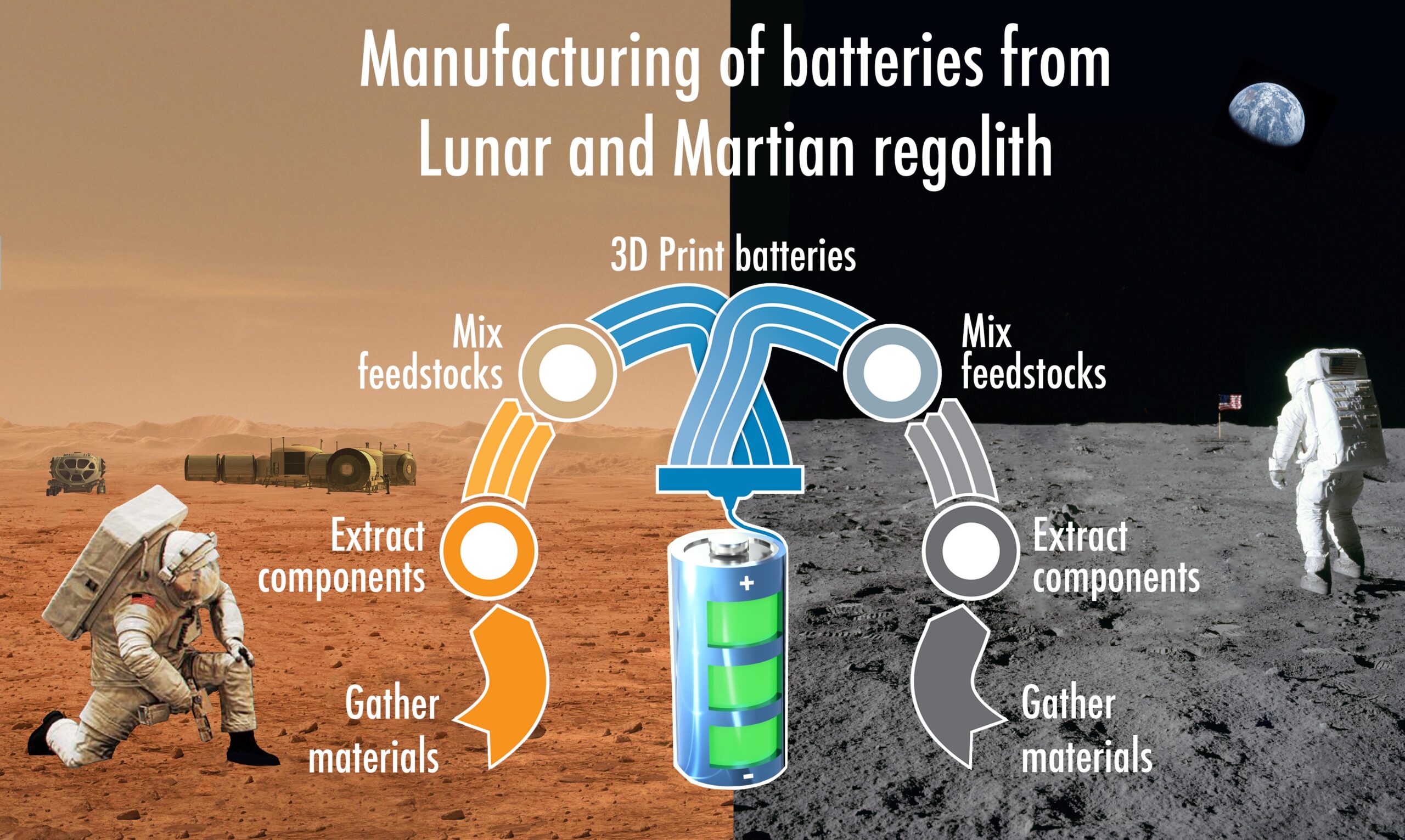Hot on the heels of previous federal grants to develop space technologies, like mining water on the Moon, the University of Texas at El Paso (UTEP) has joined a project led by NASA to 3D print rechargeable batteries using lunar and Martian regolith, which is the top layer of materials that covers the surface of the Moon and Mars. By tapping into the bread and butter of future 3D printed projects, that is, in-situ resource utilization (ISRU), the technology could maximize the sustainability of space crews in upcoming Artemis missions to the Moon and Mars by reducing payload weight and dead volume and supporting the development of an Artemis Base Camp on the surface of the Moon, which is being planned for 2028.
Widely available resources on the Moon or Mars are crucial to developing the infrastructure for humans to survive in space. From habitation modules to power generation and energy storage facilities, there are plenty of planned missions to explore the lunar natural resource potential in the next decade. NASA is determined to put in place a sustainable infrastructure that will allow crews to examine and study the lunar landscape like never before, then develop and demonstrate technologies to use the Moon’s resources to produce water, fuel, and other supplies as well as capabilities to excavate and construct structures on the Moon, is crucial.
 UTEP joins NASA project to 3D print rechargeable batteries using lunar and Martian regolith. Image courtesy of JR Hernandez / UTEP.
UTEP joins NASA project to 3D print rechargeable batteries using lunar and Martian regolith. Image courtesy of JR Hernandez / UTEP.According to Eric MacDonald, professor of aerospace and mechanical engineering and associate dean at the UTEP College of Engineering, the institute’s reputation in 3D printing and material science, as well as its state-of-the-art facilities and deep heritage in additive manufacturing (AM), were vital in convincing NASA partners to pursue this transformative investigation, which as with most NASA research, will have applications in space and on Earth.
Testbed
UTEP’s $615,000 grant is part of a broader $2.5 million project that includes Youngstown State University (YSU), 3D printer manufacturer Formlabs, as well as ICON, the private sector company currently leading the NASA Mars Dune Alpha project to 3D print future habitats on Mars, as well as NASA’s Marshall Space Flight Center, Glenn Research Center, and Ames Research Center. To detail the progress, the team has published an article titled “What Would Battery Manufacturing on the Moon and Mars Look Like?” in the January issue of ACS Energy Letters, a peer-reviewed journal from the American Chemical Society.
As stated in the document, the team’s preliminary investigations indicate that the development and optimization of high-resolution multi-material printers enabling the printability of composite battery components are critical to allow complete 3D battery manufacturing from ISRU materials on the lunar and martian surfaces in the future.
In addition, the published work highlights two types of 3D printing processes – material extrusion (ME) and vat photopolymerization (VPP) – to produce shape-conformable batteries on the Moon and Mars. These complex 3D battery designs can outperform existing commercial batteries because they can fill objects’ dimensions. The experts explain that such tailored batteries are especially well-suited for applications in small spacecraft, portable power devices, robots, and large-scale power systems for Moon and Mars habitat missions.
 Rendering of materials extraction and manufacturing of rechargeable batteries using lunar and martian ISRU as material. Image courtesy of NASA.
Rendering of materials extraction and manufacturing of rechargeable batteries using lunar and martian ISRU as material. Image courtesy of NASA.Aside from space batteries, the team is also focusing on developing shape-conformable batteries that can be used on Earth. For example, these batteries could be embedded in 3D printed concrete walls and connected to solar power generation to create compact, self-sustaining homes for disaster response in developing countries.
Experimental
Spacecraft like the International Space Station (ISS) and exploration robots rely on lithium-ion (Li-ion) batteries for primary power. However, the team explains that manufacturing Li-ion batteries from ISRU materials to support future long-term missions on the Moon and Mars is not viable since lithium is scarcely available on the Moon. That is why, for this project, the UTEP research team is currently focusing on sodium-ion battery chemistry based on the greater abundance of sodium. Although sodium concentrations are relativity low in all lunar materials, they cover a substantial range in residual melt rocks, and on Mars, the sodium concentration is even higher. In addition, other crucial battery components like separators could be prepared on the Moon or Mars by recycling waste packaging materials.
“This project with NASA is an opportunity to demonstrate UTEP’s expertise in both energy storage and 3D printing,” said Alexis Maurel, postdoctoral researcher, and French Fulbright Scholar at the UTEP Department of Aerospace and Mechanical Engineering. “Additive manufacturing appears as a unique approach to manufacture shape-conformable batteries to support human operations in space and on the surface of the moon or Mars, where cargo resupply is not as readily available.”
 Alexis Maurel and Ana Cristina Martinez Maciel printing batteries. Image courtesy fo UTEP.
Alexis Maurel and Ana Cristina Martinez Maciel printing batteries. Image courtesy fo UTEP.In the project’s initial phase, NASA, UTEP, and YSU will identify and work on extracting battery materials and precursors from lunar and Martian regolith. The UTEP and YSU team has already developed and 3D printed, using VPP technology, composite resin feedstocks for each part of the sodium-ion battery (that includes electrodes, electrolyte, and current collector). In addition, the team at NASA Marshall Space Flight Center and Ames Research Center developed 3D printed composite inks using material extrusion for the different battery components. Finally, UTEP and NASA’s Glenn Research Center electrochemically test the completed 3D printed sodium-ion battery components.
A lack of battery power could disrupt critical operations off-Earth. So building better batteries for space exploration is vital. New energy storage technologies to replace the battery systems currently used on Earth will address the main challenges of living in outer space, especially learning how to manufacture them from raw resources on-site. Any material derived from ISRU is one less feedstock that needs to be transported from Earth to space. These next-generation batteries could help power the highly-anticipated Artemis missions, capable of being built in the harsh space environment.
Subscribe to Our Email Newsletter
Stay up-to-date on all the latest news from the 3D printing industry and receive information and offers from third party vendors.
You May Also Like
Gorilla Sports GE’s First 3D Printed Titanium Cast
How do you help a gorilla with a broken arm? Sounds like the start of a bad joke a zookeeper might tell, but it’s an actual dilemma recently faced by...
Nylon 3D Printed Parts Made More Functional with Coatings & Colors
Parts 3D printed from polyamide (PA, Nylon) 12 using powder bed fusion (PBF) are a mainstay in the additive manufacturing (AM) industry. While post-finishing processes have improved the porosity of...
$25M to Back Sintavia’s Largest Expansion of Metal 3D Printing Capacity Since 2019
Sintavia, the digital manufacturing company specializing in mission-critical parts for strategic sectors, announced a $25 million investment to increase its production capacity, the largest expansion to its operations since 2019....
Velo3D Initiates Public Offering in a Bid to Strengthen Financial Foundations and Drive Future Growth
Velo3D (NYSE: VLD) has been among a number of publicly traded 3D printing firms that have attempted to weather the current macroeconomic climate. After posting a challenging financial report for 2023,...































